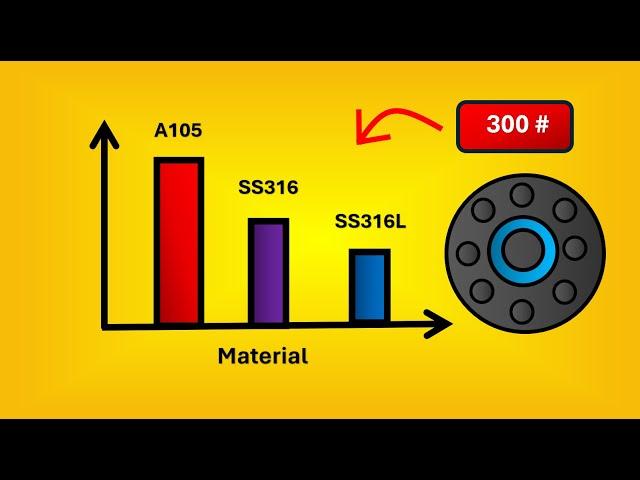
How to Calculate ASME Flange Ratings Explained
ASME standards, including ASME B16.5, B16.47, B16.36, and B16.34, provide guidelines for the design, manufacturing, and testing of pipe flanges and flanged fittings. These standards play a crucial role in ensuring the safety and reliability of piping systems in various industries. One aspect that often confuses engineers and professionals is the presence of various flange ratings within these standards. This video aims to explain why there are different flange ratings in ASME standards, focusing on ASME B16.5, B16.47, B16.36, and B16.34 as primary examples.
( 🔴 ) Link to FREE Udemy Course for I&C Professionals
1500+ Engineers have taken the Course
(Engineers have said it is even BETTER than the PAID Courses available)
Give it a Try 😊
Link 👉 https://asad-shaikh-instrumentation.ck.page/06e66ac455
🔴 FREE E-book on Control Valves
👉Link to Download : https://www.asad-shaikh.com/control-valve-mastery.html
Understanding ASME Flange Ratings:
ASME B16.5 covers pipe flanges and flanged fittings in sizes ranging from NPS 1/2 to NPS 24 and includes multiple pressure-temperature ratings, such as 150, 300, 600, 900, 1500, and 2500. Similarly, ASME B16.47 covers large diameter steel flanges from NPS 26 to NPS 60 and includes Series A and Series B flanges with different pressure ratings. ASME B16.36 covers orifice flanges, while ASME B16.34 covers valves, both of which include flange specifications with varying pressure-temperature ratings.
Reasons for Variation:
Operating Conditions: The variation in flange ratings accounts for different operating conditions, including pressure and temperature, that piping systems may encounter. A higher flange rating indicates the flange's ability to withstand higher pressures and temperatures.
Material Compatibility: Flange ratings also consider the material compatibility of the flange and the piping system. Different materials have different mechanical properties, which affect their ability to withstand pressure and temperature.
Safety Factors: ASME standards incorporate safety factors to ensure that flanges are designed to operate safely under specified conditions. Higher flange ratings provide a greater margin of safety, especially in critical applications.
Application Specificity: Industries and applications may have specific requirements that necessitate different flange ratings. For example, high-pressure or high-temperature applications may require flanges with higher ratings to ensure system integrity.
( 🔴 ) Link to FREE Udemy Course for I&C Professionals
1500+ Engineers have taken the Course
(Engineers have said it is even BETTER than the PAID Courses available)
Give it a Try 😊
Link 👉 https://asad-shaikh-instrumentation.ck.page/06e66ac455
🔴 FREE E-book on Control Valves
👉Link to Download : https://www.asad-shaikh.com/control-valve-mastery.html
Understanding ASME Flange Ratings:
ASME B16.5 covers pipe flanges and flanged fittings in sizes ranging from NPS 1/2 to NPS 24 and includes multiple pressure-temperature ratings, such as 150, 300, 600, 900, 1500, and 2500. Similarly, ASME B16.47 covers large diameter steel flanges from NPS 26 to NPS 60 and includes Series A and Series B flanges with different pressure ratings. ASME B16.36 covers orifice flanges, while ASME B16.34 covers valves, both of which include flange specifications with varying pressure-temperature ratings.
Reasons for Variation:
Operating Conditions: The variation in flange ratings accounts for different operating conditions, including pressure and temperature, that piping systems may encounter. A higher flange rating indicates the flange's ability to withstand higher pressures and temperatures.
Material Compatibility: Flange ratings also consider the material compatibility of the flange and the piping system. Different materials have different mechanical properties, which affect their ability to withstand pressure and temperature.
Safety Factors: ASME standards incorporate safety factors to ensure that flanges are designed to operate safely under specified conditions. Higher flange ratings provide a greater margin of safety, especially in critical applications.
Application Specificity: Industries and applications may have specific requirements that necessitate different flange ratings. For example, high-pressure or high-temperature applications may require flanges with higher ratings to ensure system integrity.
Тэги:
#Instrumentation #Pressure_transmitter #Level_Transmitter #Flow_Trasnmiiter #Control_Valves #Working #Instrumentation_and_control #ASME_standards #ASME_B16.5 #asme_16.34 #ASME_16.47 #ASME_B_16.36Комментарии:
How to Calculate ASME Flange Ratings Explained
Asad (I&C Engineer)
Просто так)
Хоринск онлайн
Me Project - 10 Milion Hay
Karen Sevak
Al Di Meola - RACE WITH DEVIL ON SPANISH HIGHWAY Live
MJB Entertainment USA
How much my dividend portfolio paid me this year! | August 2023
Gifford - Journey To A Million Dollars
Tsuki Ga Kieri Jab Tak Song || Yui Official fandom Ss Lover •
Yui Official Fandom Śš Lover


























